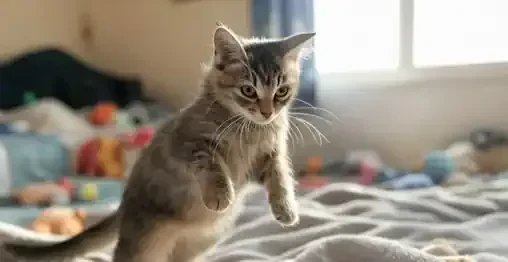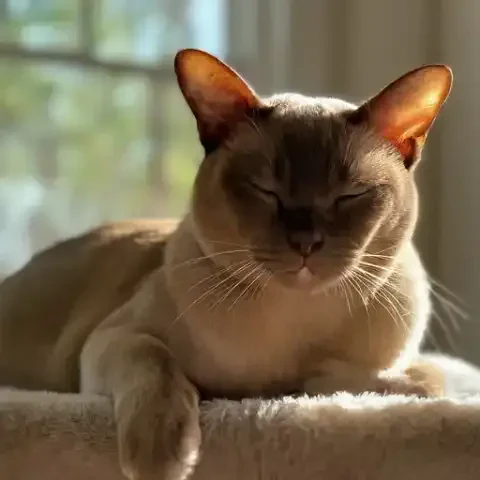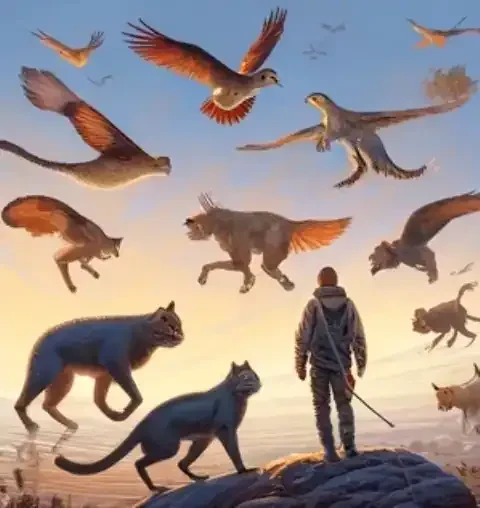The world holds few spectacles as captivating as the sudden, explosive grace of a cat in motion. One moment, serene repose, perhaps a languid stretch in a sunbeam, the next, a lightning strike of fur and focused intent, culminating in the precise capture of unsuspecting prey. This is the pounce – the signature move of the feline hunter, a ballet of instinct and honed skill played out countless times in backyards and wildlands alike. We observe it with a mixture of awe and perhaps a touch of trepidation for the targeted toy mouse or feathered teaser, instinctively recognizing the inherent artistry in the action. But beneath the surface of this seemingly effortless display lies a complex interplay of biological systems, a finely tuned machine honed by millennia of evolutionary pressure. To truly appreciate the “art of the pounce,” we must delve deeper than mere observation, venturing into the realm of scientific investigation to unravel the intricate mechanisms that make this feat of predatory prowess possible.
More than just a simple jump, the pounce is a culmination of sensory acuity, biomechanical engineering, and neural programming, all working in perfect synchronicity. It’s a behavior far richer and more nuanced than simple instinct; it's a learned and refined skill, perfected through play, practice, and generations of successful hunts. From the domestic tabby stalking a rogue housefly to the lioness bringing down a zebra on the savanna, the core principles of the pounce remain remarkably consistent, a testament to its evolutionary efficacy. Therefore, this exploration aims to move beyond admiring glances, to scientifically dissect this iconic feline behavior, understanding not just what happens, but how it happens. We will embark on a journey through the senses that prime the pounce, the biomechanics that power it, the neural pathways that orchestrate it, and the learned strategies that refine it, ultimately revealing the scientific symphony that underpins the “Art of the Pounce.” This article will illuminate how the seemingly simple act of a cat catching its prey is in reality a sophisticated and scientifically explainable behavior, reliant on a remarkable convergence of senses, biomechanics, neural control, and learned strategies for achieving predatory success. We will trace the path from the initial sensory awareness of prey to the final, decisive capture, unveiling the layers of complexity embedded within this quintessential feline maneuver.
The foundation of any successful pounce lies in the cat’s extraordinary sensory apparatus, a suite of evolved senses finely tuned for detecting and locating prey, often in environments of low light and dense cover. At the forefront of this sensory arsenal is vision, particularly adapted for the nocturnal or crepuscular hunting habits of most felines. Cat eyes, those luminous orbs that seem to glow in the dark, possess a remarkable structure called the tapetum lucidum, a reflective layer behind the retina. This acts like a mirror, bouncing light that passes through the retina back again, giving photoreceptor cells a second chance to capture photons. This ingenious adaptation significantly enhances light sensitivity, allowing cats to see in light levels that would appear near total darkness to humans. Furthermore, feline retinas are dominated by rod cells, photoreceptors specialized for low-light vision, further maximizing their ability to perceive their surroundings under dim conditions. This nocturnal prowess is not merely about seeing in the dark; it's about initiating and executing a pounce at dawn or dusk, or even under the cloak of night, when many prey animals are most active and vulnerable.
Beyond simply seeing in low light, feline vision excels at motion detection, a crucial attribute for spotting scurrying rodents or flitting birds amongst foliage. Their visual system is highly sensitive to even subtle movements, allowing them to discern prey from background clutter with remarkable efficiency. This acute motion sensitivity isn't just about seeing movement, it’s about anticipating trajectory, predicting where the prey will be, crucial for timing the perfect interceptive pounce. Adding to this visual toolkit is binocular vision, the ability to use both eyes together to perceive a single image. The significant overlap in the visual fields of a cat’s eyes provides excellent depth perception, allowing for accurate distance judgment. This stereoscopic vision is paramount for a predator that relies on precise leaps and bounds to close the distance to its prey. Accurate depth perception isn't merely about judging distance; it’s about calculating the precise trajectory and force needed for a successful pounce, ensuring they land accurately and decisively upon their target.
While vision provides a crucial long-range detection and targeting system, hearing plays an equally vital role, especially in close-quarters hunting or when prey is obscured. Cats possess an extraordinary range of hearing, particularly at high frequencies, allowing them to detect the ultrasonic squeaks and rustling sounds of rodents and other small mammals from remarkable distances. Their auditory range extends far beyond human capabilities, opening up an entire soundscape invisible to our ears, a soundscape teeming with the subtle cues of potential prey. Adding to this auditory prowess is the remarkable mobility of feline pinnae, the external ear flaps. Cats can move each ear independently, rotating them through a wide arc to pinpoint the exact source of a sound with incredible precision. This ability to triangulate sound sources isn't merely about hearing; it’s about precisely locating hidden prey, even beneath leaf litter or within dense undergrowth, allowing them to orient themselves perfectly for the final stalk and pounce.
Beyond the well-known senses of sight and sound, touch and proprioception, the sense of body awareness, contribute subtly yet significantly to the art of the pounce. Vibrissae, more commonly known as whiskers, are highly specialized tactile sensory organs, far more than mere facial hair. Embedded deep within whisker follicles are numerous nerve endings, making them incredibly sensitive to even minute changes in air currents. These sophisticated sensors act as extensions of the cat's sensory world, providing information about their immediate surroundings, even in complete darkness. Whiskers aren't merely about feeling; they are about sensing spatial dimensions, detecting changes in air currents that might indicate the presence or movement of prey, even in the dark or in cluttered environments, providing crucial spatial awareness for navigating the final stages of the stalk and pounce. Furthermore, proprioception, the body’s sense of its own position and movement in space, is highly developed in cats. This internal awareness allows for incredibly precise and coordinated movements, crucial for maintaining balance during rapid maneuvers and making mid-air adjustments during a pounce. Proprioception isn’t merely about balance; it’s about the subtle adjustments in posture and limb placement that allow for incredible agility and precision, ensuring they can land accurately and maintain stability even on uneven terrain during the dynamic act of pouncing.
Once the senses have located and assessed the prey, the biomechanics of the pounce take center stage, transforming sensory information into explosive action. The feline muscular system is a marvel of evolutionary engineering, perfectly adapted for short bursts of speed, agility, and power. The hind legs are the engines of the pounce, packed with powerful muscle groups like the gastrocnemius and quadriceps, responsible for generating the propulsive force for leaps and bounds. These muscles are not merely strong; they are designed for rapid contraction and explosive power output, launching the cat forward with surprising speed and acceleration. It’s not just about leg muscles in isolation; the entire musculoskeletal system works in concert. The flexible spine and pelvis of a cat are not just about grace; they are crucial biomechanical adaptations. The exceptional flexibility allows for an incredible range of motion, enabling the cat to extend and rotate its body during the pounce, increasing stride length and maximizing propulsive force. This spinal flexibility isn't just about flexibility; it’s about converting muscle power into maximum forward momentum and allowing for mid-air adjustments to maintain balance and trajectory during the dynamic leap.
Adding to the biomechanical arsenal are retractable claws, a defining feature of most felines. These razor-sharp claws are not merely weapons; they are essential tools for grip, traction, and securing prey. Retraction keeps the claws sharp when not in use, preserving their pristine cutting edge for the crucial moment of capture. During the pounce, the claws are extended, providing purchase on the ground for powerful propulsion and then acting as grappling hooks to secure prey upon landing. Retractable claws aren't merely about weapons; they are about enhancing traction and control during the pounce, ensuring a secure grip on both the terrain and the prey. While precise measurements are challenging in the unpredictable context of a live hunt, it's clear that cats are built for speed, at least in short bursts. They are sprinters, designed for rapid acceleration over short distances rather than sustained endurance running. This sprint capability isn't about marathon speed; it’s about the explosive burst of acceleration required to close the distance to prey quickly and decisively in a pounce. This speed is coupled with incredible agility and maneuverability. Cats can change direction mid-pounce, adjusting their trajectory in response to unpredictable prey movement, demonstrating remarkable control even in mid-air. This agility isn’t just about changing direction; it’s about the fine-tuned neuromuscular control that allows for rapid adjustments and course corrections during the dynamic and unpredictable act of pouncing on live prey.
Observing a cat pounce reveals a characteristic body posture, low to the ground in the stalking phase, then launching forward with a flattened body and extended limbs. This posture isn't just about appearance; it reflects key biomechanical principles. A low center of gravity enhances stability and balance, crucial for maintaining control during rapid movements and sudden changes in direction. The flattened body profile reduces air resistance during the pounce, maximizing speed and efficiency of movement. Body posture isn't merely about appearance; it’s about maximizing stability, minimizing resistance, and optimizing the transfer of power from muscles to movement during the pounce. The tail, often flicking and twitching during the stalk and pounce, plays a vital role as a counterbalance. During rapid movements and aerial maneuvers, the tail acts as a dynamic stabilizer, shifting weight to maintain equilibrium and adjust balance. The tail isn’t merely decorative; it is a crucial tool for dynamic balance, acting as a rudder and counterbalance during the rapid and agile movements of a pounce.
Beneath the sensory input and biomechanical execution lies the neural control and ingrained predatory instincts that drive the entire pounce sequence. Feline predatory behavior is deeply rooted in instinct, hardwired into their neural circuits. Brain structures like the hypothalamus and amygdala, regions associated with basic drives and emotional responses, play key roles in regulating predatory motivation and behavior. These brain regions aren’t merely structures; they are the seats of innate predatory drives, pre-programmed neural pathways that predispose cats to hunt. Predatory behaviors often manifest as fixed action patterns, innate sequences of actions triggered by specific stimuli. Stalking, crouching, the characteristic "butt wiggle" before a pounce, and the pounce itself can be considered fixed action patterns, genetically programmed behaviors triggered by the sight, sound, or smell of potential prey. Fixed action patterns aren't merely reflexes; they are complex, pre-programmed behavioral sequences that form the foundation of feline hunting strategy.
However, while instinct provides the foundational framework, learned behavior and refinement play a crucial role in shaping and perfecting the pounce. Play behavior, particularly in kittens, is not just frivolous amusement; it’s essential practice for developing and honing pounce skills. Chasing toys, batting at dangling objects, and playful wrestling with siblings all contribute to developing the coordination, timing, and motor skills necessary for successful hunting. Play isn't merely play; it's a crucial training ground for honing the motor skills and coordination required for the complex act of pouncing. Observation and imitation likely play a role as well. Kittens may learn hunting techniques by observing their mothers or other experienced cats, refining their own strategies through social learning. Observation isn’t just passive learning; it’s a way for kittens to acquire and refine hunting techniques by mimicking successful adult behavior. Furthermore, cats are capable of adaptive learning, adjusting their pounce technique based on experience. Trial and error learning allows them to refine their approach, adapt to different prey types and environments, and improve their success rate over time. Adaptive learning isn’t just about repeating successes; it’s about constantly refining and optimizing hunting strategies based on experience and feedback from previous hunts. Even in the seemingly instinctive act of the pounce, there is an element of decision-making. Cats must assess prey size, distance, and movement, timing their pounce strategically to maximize their chances of success. This decision-making, though often rapid and seemingly intuitive, represents a cognitive component to the pounce, a brief assessment of the situation before action is taken.
The "art of the pounce" is also influenced by external factors, the specific context of each hunt. Prey type and size significantly impact pounce strategy. For small, fast prey like rodents or birds, a quick, decisive pounce is often employed, aiming for immediate capture. Larger prey, or perhaps more elusive insects or lizards, might elicit variations in approach, pounce height, and follow-up actions, demonstrating adaptability based on the target. Prey type isn't just about target size; it's about adapting pounce strategy to the specific characteristics and escape tactics of different prey animals. Habitat and terrain are equally influential. In open fields, a long-range stalk might precede a more extended pounce. In dense undergrowth, a shorter, more explosive ambush pounce might be favored. Vertical surfaces, like trees or shelves, might necessitate specialized vertical pounces, demonstrating the versatility of feline hunting techniques across diverse environments. Habitat isn't merely background; it actively shapes pounce strategy, dictating the optimal approach and technique based on environmental constraints.
Finally, prey behavior itself is a crucial factor. Cats must anticipate and react to prey movement and escape strategies. Often, a cat will position itself to cut off potential escape routes before initiating the pounce, demonstrating strategic spatial awareness. And during the pounce itself, they possess the flexibility to alter their trajectory mid-air, adapting to sudden changes in prey direction. Prey behavior isn't just passive resistance; it’s a dynamic element that forces cats to adapt, anticipate, and adjust their pounce in real-time.
Even after scientifically dissecting the pounce into its sensory, biomechanical, and neural components, a sense of wonder remains. Understanding the science only deepens the appreciation for the "art," revealing the intricate biological symphony that underpins this seemingly simple act. While we have unveiled much of the mechanism, unanswered questions remain, fertile ground for future research. The precise neural basis of decision-making during the pounce, the subtle cognitive calculations involved in timing and trajectory, still require further investigation. Individual variation in pounce style, differences between breeds and individual cats, warrants exploration. And tracing the evolutionary history of the pounce, understanding its development across feline lineages, remains an intriguing area of study.
Ultimately, the feline pounce stands as a testament to evolutionary adaptation, a showcase of biological sophistication, and a captivating example of the inherent beauty found within the natural world. By moving beyond simple admiration and engaging in scientific inquiry, we gain a richer, deeper appreciation for this iconic behavior, recognizing it not just as an instinctive act, but as a masterful performance honed by millions of years of evolution, a true "Art of the Pounce," scientifically understood and profoundly admired. Observing a cat pounce, armed with this scientific understanding, transforms the experience from a mere fleeting moment of animal behavior into a glimpse into the intricate workings of life itself, a reminder of the elegant complexity woven into even the seemingly simplest acts in the natural world.







